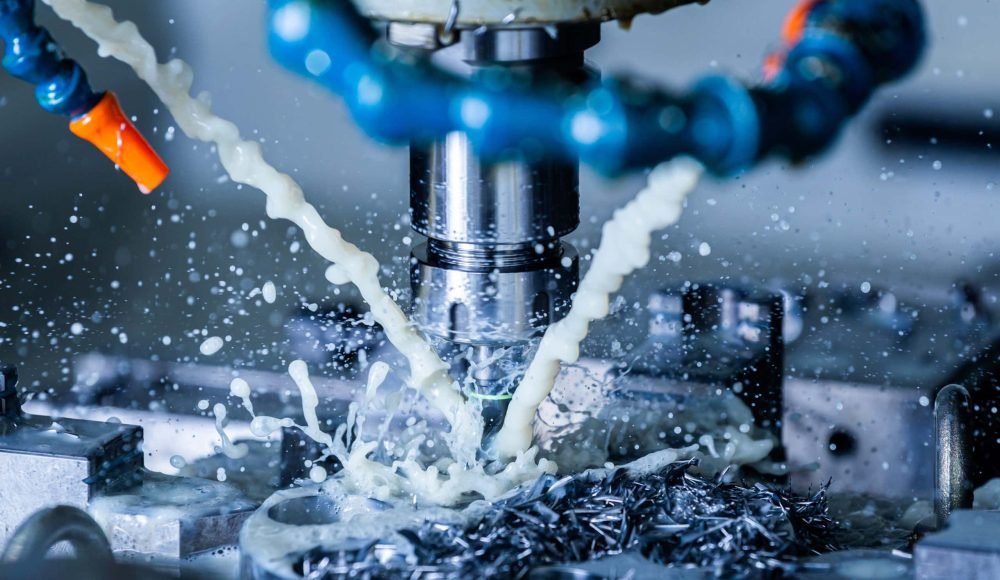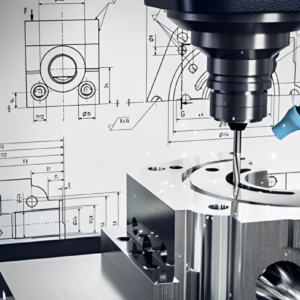En la fabricación moderna, Control numérico por computadora (CNC) mecanizado ha transformado la forma en que se hacen los componentes de precisión. Las máquinas CNC automatizan procesos de fabricación complejos, Reducir errores y aumentar la eficiencia. Entre los muchos Mecanizado CNC metodos, Giro de CNC y fresado CNC son los dos más utilizados.
Sin embargo, Muchos fabricantes luchan por comprender sus diferencias y cuándo usar cada método. Mientras que ambos son procesos de fabricación sustractivos, retirando material para dar forma a un producto final, su mecanismos, estampación, y las aplicaciones difieren significativamente.
Esta guía tomará un profundizar en la giro y fresado de CNC, Explorando sus diferencias, ventajas, aplicaciones, y rentabilidad. Al final, Tendrás un comprensión clara de cuándo elegir fresado CNC vs. torneado CNC para sus necesidades de fabricación.
¿Qué es el torneado CNC??
Conceptos básicos de giro de CNC
CNC Turning es un proceso de mecanizado donde una pieza de trabajo gira a altas velocidades Mientras que un estacionario La herramienta de corte elimina el material. Este método es más adecuado para componentes cilíndricos o redondeados, como ejes., boquillas, y anillos.
A diferencia de los tornos manuales, El giro de CNC está completamente automatizado y controlado a través de programas computarizados, Asegurar una alta precisión y eficiencia.
Cómo funciona el giro de CNC
- Configuración de la pieza de trabajo: El maquinista asegura una pieza de trabajo cilíndrica en un arrojar en el torno de CNC.
- Rotación: El chuck gira la pieza de trabajo a altas velocidades.
- Movimiento de herramientas de corte: La herramienta de corte se mueve a lo largo de los ejes X y Z, afeitarse el material para crear la forma deseada.
- Múltiples operaciones: El giro de CNC permite procesos adicionales como perforación, aburrido, nudoso, y enhebrado.
- Terminación: Una vez que el mecanizado está terminado, El componente es remoto, limpio, y check de calidad.
Operaciones de giro de CNC
Las máquinas de giro de CNC pueden realizar varias operaciones, incluido:
- Frente a: Cortando el extremo de la pieza de trabajo para hacerlo plano.
- Aburrido: Ampliar un agujero existente.
- Perforación: Creación de agujeros cilíndricos en la pieza de trabajo.
- Nudoso: Producir patrones texturizados para un mejor agarre.
- Torneado cónico: Creando una forma cónica.
- Corte de hilo: Tallas de tornillo en la pieza de trabajo.
Tornos de CNC vs. Centros de torneado CNC
| Característica | Tornos CNC | Centros de torneado CNC |
| Número de herramientas | 1-2 herramientas de corte | Múltiples herramientas de corte |
| Movimiento del eje | 2-Eje (incógnita, z) | Múltiplo (incógnita, Y, z, C) |
| Complejidad | Más simple | Puede manejar formas complejas |
| Funcionalidad | Operaciones de giro básicas | Puede realizar fresado y perforación |
Para llevar: CNC tornos son ideales para piezas cilíndricas simples, Mientras CNC Centros de giro son más avanzados, Ofrecer capacidades de múltiples eje para diseños intrincados.
¿Qué es el fresado CNC??
Conceptos básicos de la molienda CNC
La fresación CNC es un proceso de mecanizado donde el La pieza de trabajo permanece estacionaria Mientras que un La herramienta de corte múltiple giratoria elimina el material. A diferencia de la giro de CNC, que funciona mejor para las piezas cilíndricas, La fresación CNC es versátil y puede crear departamento, irregular, o componentes altamente complejos.
Cómo funciona la fresación CNC
- Configuración de la pieza de trabajo: El material se asegura en el cama de máquina o en un tornillo.
- Rotación del husillo: El hurra de la herramienta de corte a altas velocidades.
- Movimiento de herramientas: La herramienta de corte se mueve en múltiples direcciones (incógnita, Y, z) Para cortar el material.
- Modelado de precisión: Las máquinas de fresado CNC pueden producir bolsillos, tragamonedas, agujeros, y intrincadas formas 3D.
- Terminación: El componente terminado se somete Postprocesamiento, desacuerdo, e inspección.
Tipos de fresadoras CNC
| Tipo de máquina | Número de ejes | Mejor para |
| 3-Fresadora de eje | incógnita, Y, Z Movimiento | Tareas de mecanizado básicas |
| 4-Fresadora de eje | Agrega el eje A rotacional | Partes más complejas |
| 5-Fresadora de eje | incógnita, Y, z + rotación en dos ejes | Geometrías altamente intrincadas |
Para llevar: El mayor el número de hachas, cuanto más complejas son las capacidades de diseño, pero también la mayor el costo de mecanizado.
Ventajas del fresado CNC
- Maneja formas complejas: Puede crear componentes simétricos y asimétricos.
- Alta precisión: Capaz de tolerancias dentro de ± 0.01 mm.
- Compatibilidad de material versátil: Trabajar con rieles, plástica, y compuestos.
- Operaciones múltiples en una configuración: Poder perforar, ranura, grabar, y terminar en un solo pase.
Diferencias clave entre el giro de CNC y la fresado CNC
| Característica | Torneado CNC | Fresado CNC |
| Movimiento de la pieza de trabajo | Giras | Estacionario |
| Movimiento de herramientas de corte | Estacionario | Giras |
| Tipo de herramienta de corte | De punto único | Múltiple |
| Mejor para | Partes cilíndricas | Partes irregulares/complejas |
| Compatibilidad de materiales | Más adaptable | Más selectivo |
| Aplicaciones comunes | Ejes, boquillas, rodillos | Corchetes, engranajes, recintos |
Para llevar: Si su parte es cilíndrica, Use el giro de CNC. Si tiene geometrías complejas, Utilizar fresado CNC.
Cuándo elegir la fresación CNC vs. Torneado CNC?
Cuándo elegir la fresación CNC
- Si tu parte tiene complejo, irregular, o características de múltiples lados.
- Si el secundario termina como grabado o ranura es necesario.
- Si tu diseño requiere geometrías 3D.
Cuándo elegir el giro de CNC
- Si tu parte es cilíndrico, cónico, o en forma de disco.
- Si lo necesitas Producción en masa rápida y rentable.
- Si tu material es más largo y mejor adecuado para Chuck Holding.
Combinando la fresación y giro de CNC
Muchos fabricantes Combinar ambos procesos Para lograr los mejores resultados. Por ejemplo:
- Un torno de CNC primero crea la forma cilíndrica básica.
- Una fábrica CNC entonces agrega agujeros, tragamonedas, o detalles de superficie intrincados.
Este enfoque híbrido mejora eficiencia, exactitud, y rentabilidad general.
Aplicaciones de fresado CNC y giro de CNC en la fabricación
Ambos Fresado de CNC y giro de CNC jugar papeles vitales en la fabricación moderna. Estos procesos se utilizan ampliamente en varias industrias debido a su capacidad para producir precisos, durable, y componentes complejos.
Industrias que usan la fresación CNC
La fresación CNC es particularmente útil para Creación de piezas intrincadas y de forma personalizada. Las industrias que dependen en gran medida de la fresación CNC incluyen:
- Industria automotriz
Componentes del motor
Carcasa de transmisión
Soportes de suspensión
Accesorios personalizados
- Industria médica
Instrumentos quirúrgicos
Implantes protésicos
Componentes dentales
- Industria aeroespacial
Piezas estructurales de la aeronave
Palas de turbina
Componentes del tren de aterrizaje
- Industria Electrónica
Disipadores de calor
Recintos de placa de circuito
Conectores
- Defensa & Militar
Componentes de radar
Montura de arma
Sistemas de comunicación
Industrias que usan el giro de CNC
El giro de CNC se usa principalmente para componentes redondos y simétricos. Algunas de las industrias que dependen del cambio de CNC incluyen:
- Carpintería y metalworking
Columnas de madera decorativa
Huso de metal
Manijas costeras
- Industria automotriz
Cigüeñal
Ejes
Cubos de ruedas
- Industria aeroespacial
Boquillas de motor a reacción
Componentes del sistema de combustible
- Armas de fuego y defensa
Tripas de bala
Supresores
Barriles de precisión
- Fontanería e hidráulica
Accesorios de tubería
válvulas
Reguladores de presión
Componentes comunes producidos por la fresación CNC
La fresación CNC se usa para crear componentes simples y altamente complejos. Algunas piezas comúnmente fresadas incluyen:
Engranajes y ruedas dentadas
Cajas electrónicas
Bloques de motor
Implantes medicos
Piezas de máquina personalizadas
Componentes comunes producidos por CNC Turning
Dado que CNC Gurning se especializa en partes cilíndricas y rotativas, es mejor para la fabricación:
Pistones y cilindros
Hilos y sujetadores
Boquillas y válvulas
Ejes de turbina
Rodamientos y bujes
Consideraciones de costos: Es CNC girando más barato que la fresado CNC?
Una de las preguntas más comunes que hacen los fabricantes es: ¿Qué proceso es más rentable? CNC giro o fresado CNC? La respuesta depende de varios factores:
Factores que afectan el costo de la fresación CNC vs. Torneado CNC
| Factor | Torneado CNC | Fresado CNC |
| Velocidad de producción | Más rápido para piezas cilíndricas | Más lento debido a los movimientos de múltiples eje |
| Desperdicio de materiales | Menos desechos debido a la corte rotacional | Más desechos de corte multidireccional |
| Costo de herramientas | Más bajo, Utiliza herramientas de un solo punto | Más alto, Utiliza herramientas de múltiples puntos |
| Costo de la máquina | Típicamente más bajo | Más alto, Especialmente para las fábricas de 5 ejes |
| Complejidad | Maneja las piezas redondas simples de manera eficiente | Mejor para diseños intrincados y de superficie múltiple |
Comparación de eficiencia y velocidad
El giro de CNC suele ser más rápido y más barato Al producir altos volúmenes de partes redondas. Dado que la pieza de trabajo gira, La eliminación de material es continua, Reducir los tiempos del ciclo.
fresado CNC, sin embargo, es más caro debido a su complejidad. Las máquinas de fresadores de múltiples eje requieren tiempos de configuración más largos y cambios de herramientas, que aumentan los costos de producción.
Rentabilidad en la producción a gran escala
Para producción en masa, El giro de CNC suele ser el más asequible opción. Requiere Menos cambios en la herramienta y tiene una tasa de eliminación de material más rápida. La fresación CNC es mejor para personalizado, complejo, o producción de lotes pequeños Donde es necesario detalles intrincados.
Similitudes entre la fresado CNC y el giro de CNC
A pesar de sus diferencias, CNC fresado y giro de CNC comparten varias similitudes clave:
Ambos usan tecnología asistida por computadora
Las máquinas CNC se controlan usando Diseño asistido por computadora (CANALLA) y Fabricación asistida por computadora (LEVA) software.
Esto asegura precisión, repetibilidad, y error humano mínimo.
Ambos son procesos de fabricación de sustractivos
A diferencia de la impresión 3D (fabricación aditiva), Mecanizado CNC elimina el material de una pieza de trabajo sólida para crear un producto final.
Ambos generan calor y requieren fluidos de enfriamiento
La acción de corte tanto en la fresación y girando CNC produce calor significativo, que puede dañar las herramientas o deformar materiales.
Refrigerantes y lubricantes ayudar a reducir la fricción, extender la vida útil de la herramienta, y mantener la precisión dimensional.
Ambos trabajan con una amplia gama de materiales
La fresación y giro de CNC puede procesar rieles, plástica, madera, y compuestos.
Los materiales comunes incluyen aluminio, acero, latón, titanio, y termoplásticos.
Elegir el servicio correcto de mecanizado CNC
Si eliges Girando o fresado de CNC, Seleccionar el compañero de mecanizado correcto es crucial. Esto es lo que debe considerar:
Cómo seleccionar un socio de mecanizado CNC
Experiencia y conocimientos - Busque una empresa con un historial probado en el mecanizado CNC.
Equipo y tecnología - Asegúrese de que tengan Tornos de CNC modernos y máquinas de fresado.
Capacidades materiales - Verifique si pueden trabajar con los materiales que requiere su proyecto.
Seguro de calidad - Pregunta por Certificaciones ISO, protocolos de inspección, y estándares de tolerancia.
Personalización y escalabilidad - Elija un proveedor que pueda manejar Tanto la producción como las grandes de producción.
Importancia de la creación de prototipos y las pruebas
Antes de comprometerse con la producción a gran escala, creación de prototipos Asegura que su diseño cumpla con las especificaciones.
Los servicios de mecanizado de CNC deberían ofrecer Producción de muestra y ejecución de pruebas.
Consideraciones de personalización y precisión
Si lo necesitas componentes altamente detallados y personalizados, a 5-fresadora CNC de eje puede ser la mejor opción.
Si lo necesitas de alta velocidad, producción de alto volumen, a Centro de giro de CNC es más eficiente.
Por qué la fresación CNC y el giro de CNC son esenciales en la fabricación moderna
A medida que las industrias continúan evolucionando, mecanizado de precisión desempeña un papel vital en la producción de componentes de alta calidad para diversas aplicaciones. Fresado y giro de CNC proporcionan velocidad, exactitud, y eficiencia, haciéndolos el Métodos de fabricación para empresas en todo el mundo.
Avances en tecnología CNC
CNC Machinine tiene Ven mucho de tornos y molinos manuales tradicionales. Algunos avances recientes incluyen:
5-Máquinas de fresado CNC del eje - capaz de manejar geometrías altamente complejas con mejor precisión.
Herramientas en vivo en CNC Turning Centers - Permitir fresado y giro en una sola máquina, Reducción del tiempo de producción.
AI y automatización en mecanizado CNC - Mejora la precisión, Reduce los errores, y mejora la productividad.
Máquinas CNC híbridas - Combinar aditivo (3impresión D) y sustractivo (fresado/giro) fabricación Para una mayor flexibilidad.
Estas innovaciones hacen CNC Machinine más rápido, más rentable, y mas adaptable a las necesidades de fabricación modernas.
El futuro de la fresación y giro de CNC
Con avances tecnológicos, La fresación y giro de CNC continuará evolucionando. Aquí hay algunos Tendencias clave que dan forma al futuro:
Fábricas e industria inteligentes 4.0
Las máquinas CNC ahora están integradas en fábricas inteligentes totalmente automatizadas.
Internet de las cosas (IoT) Permite monitoreo remoto y mantenimiento predictivo.
Algoritmos de aprendizaje automático optimizar las rutas de corte y el uso de herramientas.
Fabricación sostenible
Más tiendas CNC son Reducir los desechos del material Optimizando las rutas de herramientas.
Refrigerantes y lubricantes ecológicos ayudar a reducir el impacto ambiental.
Soporte de mecanizado CNC Materiales reciclables como aluminio y titanio.
Procesamiento de materiales avanzados
Las futuras máquinas CNC funcionarán con Superáctil, cerámica, y materiales a base de grafeno.
Nuevas técnicas de herramientas y corte permitirán Materiales más duros para ser mecanizados con extrema precisión.
Programación CNC de AI
El software impulsado por IA Automatizar la programación CNC y sugiera estrategias de mecanizado óptimas.
Esta voluntad Reducir el tiempo de programación y permitir que los ingenieros se concentren en Mejoras de diseño.
Pensamientos finales sobre la fresación CNC vs. Torneado CNC
Elegir el proceso de mecanizado correcto depende de requisitos de diseño, selección de material, Consideraciones de costos, y volumen de producción. Aquí hay un resumen rápido:
| Característica | Fresado CNC | Torneado CNC |
| Mejor para | Formas complejas, 3D contornos | Partes cilíndricas y simétricas |
| Movimiento de la pieza de trabajo | Estacionario | Giratorio |
| Movimiento de herramientas de corte | Gira y se mueve a lo largo de múltiples ejes | Estacionario, se mueve a lo largo de los ejes x y z |
| Aplicaciones comunes | Corchetes, recintos, engranajes | Ejes, boquillas, rodillos |
| Rentabilidad | Mayor costo por parte | Más rentable para la producción en masa |
| Precisión | Ideal para diseños detallados | Excelente para la simetría rotacional |
Para Producción de alto volumen de piezas cilíndricas, El giro de CNC es más eficiente y rentable. Si su diseño requiere geometrías complejas, Múltiples ángulos, o características 3D, La fresación CNC es la mejor opción.
¿Deberías usar fresado CNC y girar juntos??
En muchos casos, Combinando ambos métodos de mecanizado puede producir componentes de mayor calidad a un costo menor. Por ejemplo:
Paso 1: Torneado CNC - Dar forma al cuerpo cilíndrico.
Paso 2: Fresado CNC - Agregar agujeros, tragamonedas, y detalles de acabado.
Este enfoque híbrido asegura Uso óptimo de material, precisión, y ahorros de costos.
Conclusión
CNC Machining es un Tecnología de fabricación revolucionaria que ha dado forma a las industrias de dispositivos aeroespaciales a médicos. Entendiendo el Diferencias entre la molienda CNC y el giro de CNC es esencial para tomar decisiones informadas en diseño, producción, y rentabilidad.
Si eliges Fresado CNC para piezas complejas o Giro de CNC para componentes cilíndricos, Ambos procesos ofrecen precisión y confiabilidad excepcionales.
Si no está seguro de qué método de mecanizado es el mejor para su proyecto, Considere consultar un Experto en mecanizado de CNC Para garantizar la más alta calidad y eficiencia.
Preguntas frecuentes
1. Que es mejor, un torno o un molino?
Depende de su aplicación. Un torno de CNC (máquina de girar) es ideal para piezas cilíndricas, mientras Una fábrica CNC es mejor para geometrías irregulares o complejas..
2. Es CNC girando más barato que la fresado CNC?
Generalmente, Sí. El giro de CNC es más rápido y más rentable para producir Piezas redondas en grandes cantidades, Mientras que la fresación CNC es Más caro Debido a su complejidad.
3. ¿Se pueden usar la fresación CNC y la giro de CNC juntos??
Absolutamente! Muchos fabricantes Combinar ambos procesos para producir de alta precisión, componentes multifuncionales.
4. Qué materiales se pueden usar en la fresación y giro de CNC?
Ambos procesos funcionan con rieles (aluminio, titanio, acero, latón), plástica (nylon, abdominales, OJEADA), y compuestos.
5. ¿Cómo elijo el servicio de mecanizado CNC correcto??
Buscar experiencia, equipo avanzado, Certificaciones de control de calidad (YO ASI 9001), y una cartera fuerte en mecanizado CNC.






2 pensamientos sobre "Turning and Milling de CNC: una guía rápida para comprender sus diferencias”